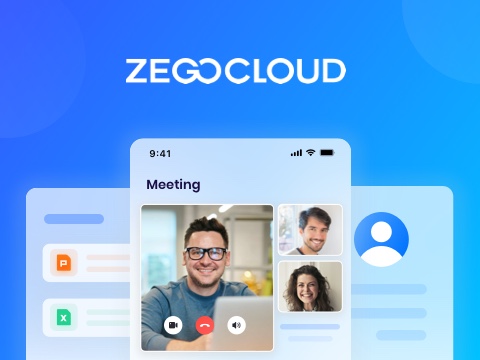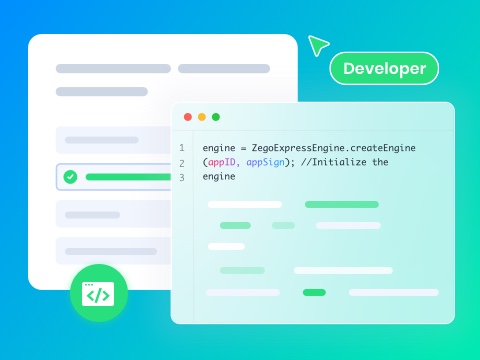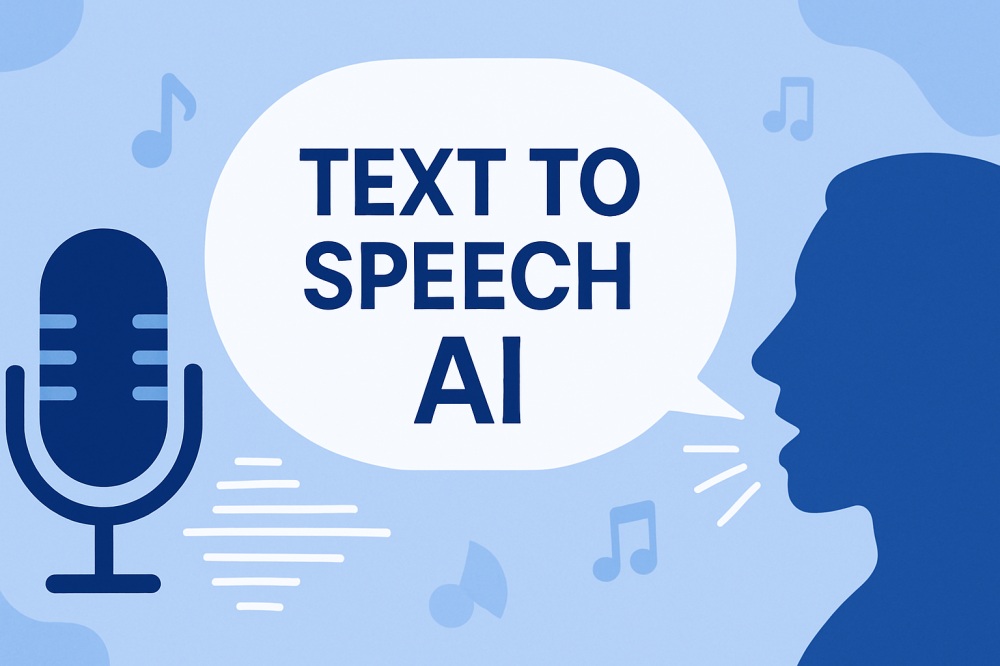Text-to-speech AI in 2025 is becoming a potent tool that is much more than just voice generation. To developers, it provides high-level customization, realistic voice recognition, and compatibility with applications, games, and live systems. In case you want to know what the buzz is about this technology, this article explains everything you should know about it.
What is Text to Speech AI?
Text-to-Speech AI is a technology that converts written text into spoken words using artificial intelligence. Hence, traditional text-to-speech systems that often sounded robotic, modern TTS AI leverages deep learning. It also applies natural language processing and sophisticated neural networks to generate speech that is very close to human tone.
Today, TTS AI is popular in many industries, such as service bots, language learning applications, games, and content generation. In addition, the developers are able to tailor voices, accents, and speaking styles to fit various situations, making TTS a personalization tool.
How Text-to-Speech AI Works
When using free text-to-speech AI technology, many users, mainly beginner developers, question “How TTS work?” So, this section offers you detailed insights into the underlying processes, from text processing to voice synthesis.
- Text Preprocessing: The process starts with the analysis and normalization of the input text, in which TTS AI expands abbreviations and breaks down the text into readable units.
- Linguistic Analysis: After that, TTS AI goes for linguistic analysis and converts words to sound transcriptions, determines prosody, and analyzes the syntax and grammar. Hence, the tool does so to ensure that pronunciations are correct and the output is natural.
- Deep Learning and Acoustic Modeling: Since TTS relies on neural networks and deep learning, its AI models then process the linguistic information. Besides, it predicts the relevant acoustic features, such as spectrograms. Neural vocoders then convert these features into waveforms and generate lifelike voices that mimic emotion and accent.
- Audio Synthesis and Output: Finally, the speech is refined through post-processing steps to upscale the clarity and naturalness. This is done before delivering the final spoken output while ensuring the sound feels expressive and human-like.
Key Features of Modern Text-to-Speech AI
Text-to-speech AI is associated with a wide range of features and capabilities that make it a powerful tool for both developers and end-users. So, read the following information and decide how these features contribute to usability:
1. Near-Human Voice Synthesis
TTS produces speech that resembles human voice, emotion, and inflection to produce a speech that is authentic and conversation-like. To that end, it relies on deep neural networks like Tacotron 2, FastSpeech, or VALL-E to encode text into mel-spectrograms. It generates the waveforms via vocoders like WaveNet while capturing the frequency and timing of speech.
2. Multilingual and Accent Support
To ensure global reach, this technology also supports multiple languages and regional accents. This is because of training on massive multilingual datasets and leveraging transformer-based language models. Additionally, text-to-speech AI engines can accurately replicate regional phonetics and intonation to ensure precise localization.
3. Emotion, Tone, and Style Controls
Besides extensive languages, TTS also has advanced controls that let users refine voices for specific emotions, pacing, and delivery styles. Prosody modeling and fine-grained control parameters allow developers to adjust pitch, rhythm, and timbre dynamically. Hence, these features ensure context-sensitive delivery of speech styles such as conversational, formal, or narrative.
4. Real-Time Streaming and Voice Cloning
With inference pipelines optimized by the use of GPU acceleration and quantization, speech can be generated in less than 100ms. However, voice cloning uses speaker embedding vectors to reproduce distinctive vocal identities to personalize them.
5. Seamless Integration and API Access
Some platforms expose RESTful APIs, WebSocket streaming, and SDKs with language bindings to integrate free text-to-speech AI. Thus, upon embedding, developers can create mobile, web, or enterprise systems without heavy infrastructure setup.
6. High Pronunciation Accuracy
Besides, context-aware grapheme-to-phoneme (G2P) models operate with phoneme dictionaries to translate text into proper sounds. The disambiguation rules also assist TTS with proper nouns, technical terminology, and multilingual text in complex sentences.
Benefits of Text-to-Speech AI
Free text-to-speech AI offers numerous benefits for accessibility, productivity, and user engagement across multiple industries. Hence, if you want to know about a few of them, review these advantages to determine its versatility:
- Accessibility Enhancement: TTS can also be used to provide access to visually impaired users or users with literacy challenges to content, with deep neural networks. Therefore, this technology is not only transforming written text into a natural-sounding speech, but it also modulates tone, pace, and emphasis.
- Multilingual and Multidialectal Support: While having context-aware grapheme-to-phoneme (G2P) models, TTS AI also comes with large multilingual training datasets. Hence, all these features ensure accurate pronunciation across languages and global access to content in regional accents.
- Improved User Engagement in Applications: This technology also ensures real-time audio generation through its integration of streaming inference techniques and edge AI deployment. Thus, this enhances the interactivity in applications, virtual assistants, and games by offering a natural conversational experience.
- Cost & Time Efficiency in Content Production: With neural TTS pipelines, you can produce audiobooks, podcasts, and tutorials without voice actors or recording studios. A single TTS model will assist you in creating thousands of hours of content in a short time.
- Data-Driven Personalization: Additionally, this technology’s models can integrate with user profile data and behavioral analytics to adjust speech parameters. This is why users can have tailored experiences, such as personalized learning tools, dynamic customer support, or adaptive story narration.
Use Cases for Text-to-Speech AI
Many users wonder how they can get the most out of the best text-to-speech AI, and the key lies in leveraging its advanced features effectively. So, to know where you can implement this technology, give in to the sequential use cases for better understanding:
1. Accessible Solutions
You can use this technology in websites, e-books, and educational material to make digital information universally accessible. Additionally, its advanced models will aid you in adjusting the tone and pacing to improve comprehension and engagement. This will be the best solution for visually impaired or low-literacy users who seek access to spoken content after converting the written one.
2. E-Learning and Education
In education, this technology can narrate lessons, tutorials, and textbooks to let slow learners learn at their own pace. Since TTS AI supports multiple languages, it will also help learners grasp complex subjects in their preferred language.
3. Audiobooks and Content Creation
Content creators can also create high-quality podcasts and audiobooks without recruiting any professional voice actors. Neural TTS systems can even imitate various voices, emotions, and styles to provide content with a natural and captivating presentation.
4. Customer Support and Virtual Assistants
When using a free text-to-speech AI in customer support, know that TTS powers interactive voice response systems and virtual assistants. Hence, these functionalities will enable you to deliver real-time spoken responses to customer queries where you can personalize the voice and adjust accents.
5. Smart Devices and IoT Applications
TTS is also popular in GPS navigation, transportation, and safety alert systems to give verbal instructions in real-time. Users or drivers are able to get immediate guidance without distraction, which improves convenience and safety.
How to Implement Text-to-Speech AI in Your App
Though text-to-speech AI offers numerous benefits and leverages various models to deliver human-like speech, implementing it in an app is quite a task. Therefore, to assist beginner developers, this section provides a detailed guide on using this technology in your target applications.
- Choose the TTS Engine or API: Pick a TTS solution, like Google Cloud Text to Speech or Microsoft Azure AI Speech, that fits your apps’ needs. Therefore, consider factors like voice quality, latency, language support, and cost to make the best choice.
- Integrate the API: Additionally, look for TTS engines that provide RESTful APIs to ensure easy integration. Besides, implement the API calls in your app’s backend or directly in the frontend, depending on your architecture.
- Control Audio Playback: As you receive the speech, integrate an audio player to play the output in your app. For mobile apps, you can use native audio APIs such as AVAudioPlayer for iOS or MediaPlayer for Android. If you want to go beyond playback and enable real-time communication features, ZEGOCLOUD’s Voice SDK can be integrated alongside TTS to support live voice chat and group audio scenarios.
- Add Customization: To improve the user experience, give users control over voice selection, speech rate, and emotional tone. Also, consider TTS models that allow you to duplicate a custom voice, which will make your application more interactive.
- Test for Quality and Accessibility: While attracting more consumers with personalization, experts recommend testing the TTS integration across devices, languages, and scenarios. Hence, this will ensure pronunciation accuracy, speech naturalness, and clarity are up to mark. Moreover, ensure that visually impaired users or users with reading difficulties can navigate your app comfortably.
Best Practices for Using Text-to-Speech AI
All developers and businesses should consider user experience and technical performance when utilizing the best text-to-speech AI. So, the following are some of the best practices that you can employ in order to make it natural and efficient:
- Focus on Naturalness and Clarity: It is always best to use TTS models that produce speech with natural emotions, speed, and intonation. This will make sure that the consumers do not feel that they are talking to a robot with less interaction and understanding.
- Minimize Latencies: In chatbots or navigation, a streaming TTS interface should be used to reduce the delays. In addition, deploy models on the edge devices or WebSocket streaming APIs to enhance the response time and user satisfaction.
- Support Multiple Languages and Accents: You should ensure that your TTS can accept a wide range of inputs and dialects when you require reaching out to a global audience. Thus, mix context-sensitive G2P models and phoneme dictionaries to avoid mispronunciation, abbreviations, and brand names.
- Offer Customization: Allow users to modify the tone, voice pitch, and speed to achieve personalized results in real-time. You can also employ some sophisticated systems that facilitate emotional speech synthesis and voice cloning.
- Control Resource Usage: Because neural TTS models can be quite resource-intensive, pre-trained embedding and lightweight neural vocoders are preferable. Therefore, this will assist you in striking a balance between performance and the constraints of the device to conserve bandwidth and computation.
The Future of Text-to-Speech AI
Text-to-speech AI technology is rapidly evolving, and future advancements will focus on emotional intelligence to enable AI voices to adapt tones. In 2025, this market will reach between $4.96 billion and $7.6 billion, depending on research sources, with annual growth rates ranging from 13.7% to 19.5%. Additionally, by 2029, forecasts suggest the industry could approach $9.98 billion in value.
User behavior is also driving adoption, as around 70% of people aged 18–25 say they prefer consuming content with both audio and captions. Besides, the wearable AI market, which includes TTS technology, is projected to be worth $180 billion by 2025. Moreover, the automotive sector is the fastest-growing TTS industry vertical, with an estimated CAGR of 14.8% in 2030, thanks to in-car navigation, infotainment, and safety features.
How ZEGOCLOUD Transforms Text-to-Speech AI into Live Conversations
Now, ZEGOCLOUD transforms text-to-speech AI into live, interactive conversations by treating AI agents as real participants in voice calls, video rooms, and live streams. Additionally, AI agents can actively engage with human users since they function on NLP, ASR, and TTS. The audio pipeline includes speech recognition, instant TTS synthesis, and dynamic conversation management.
Users can achieve a latency as low as 1 second for voice responses and under 200ms for lip-synced avatar generation. AI agents can participate in group calls, identify multiple participants, and manage interruptions.
Additionally, there are features such as AI Noise reduction and AI Acoustic Echo Cancellation that users can employ in order to minimize the background distractions. Users can also easily transition from voice to video chats and stop output within 500ms.
Conclusion
In conclusion, text-to-speech AI transforms human interaction with digital content, services, and devices. Thus, this guide has equipped you with information about this technology and how to easily incorporate it into your applications. Nevertheless, when you prefer to engage with TTS technology in real-time, the ZEGOCLOUD AI Agent API provides you with many options to make the conversations more realistic.
FAQ
Q1: What is Text to Speech AI?
Text to Speech AI (TTS AI) is a technology that converts written text into spoken voice using artificial intelligence. Modern TTS systems leverage deep learning to generate natural, human-like voices.
Q2: How does Text to Speech AI work?
TTS AI uses natural language processing (NLP) to analyze text, then applies deep neural networks to generate audio that mimics human speech patterns, tone, and intonation.
Q3: What are the challenges of Text to Speech AI?
Challenges include maintaining naturalness across long dialogues, reducing latency for real-time applications, ensuring accuracy with complex text, managing compute costs, and achieving compliance in regulated industries.
Let’s Build APP Together
Start building with real-time video, voice & chat SDK for apps today!










